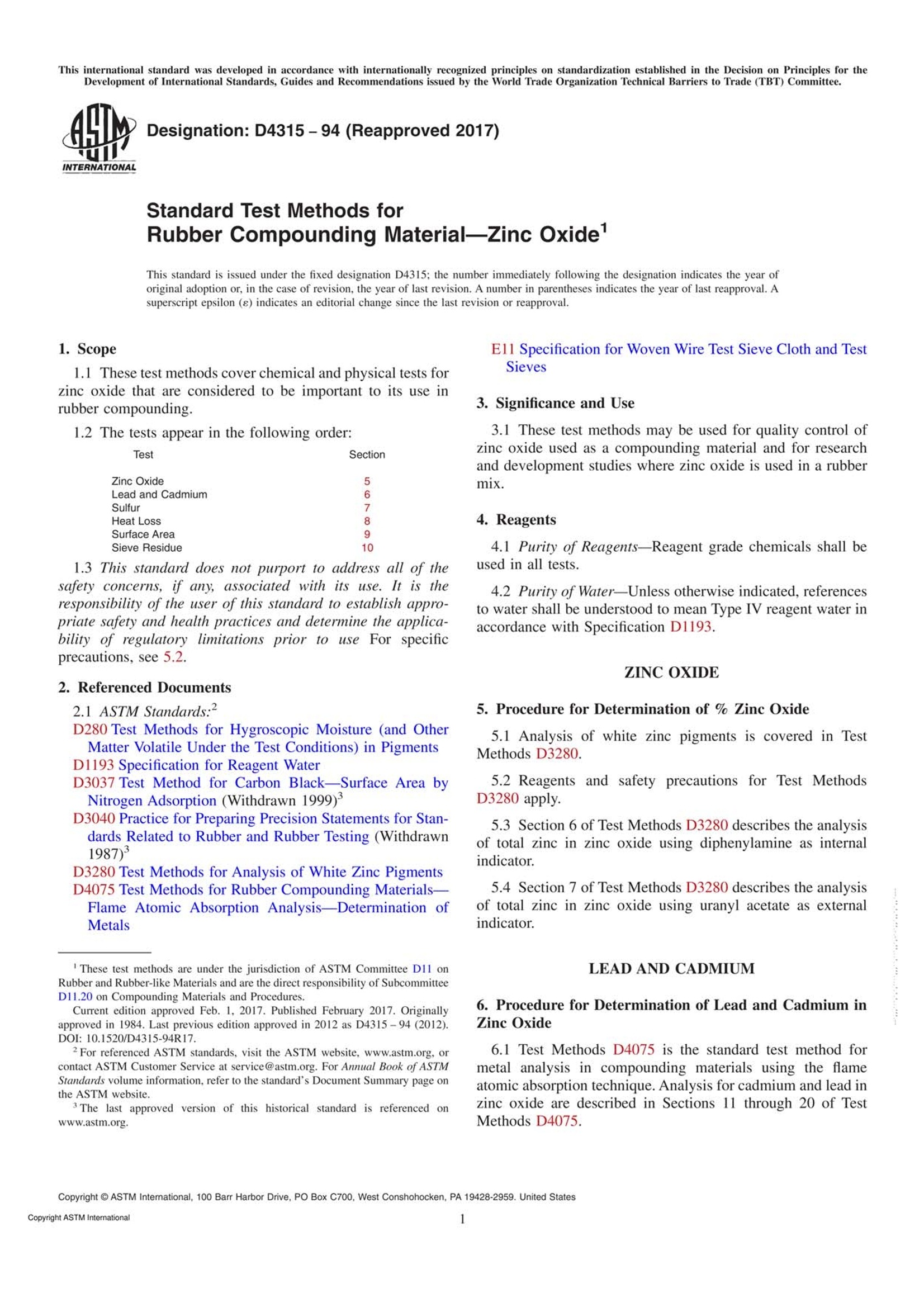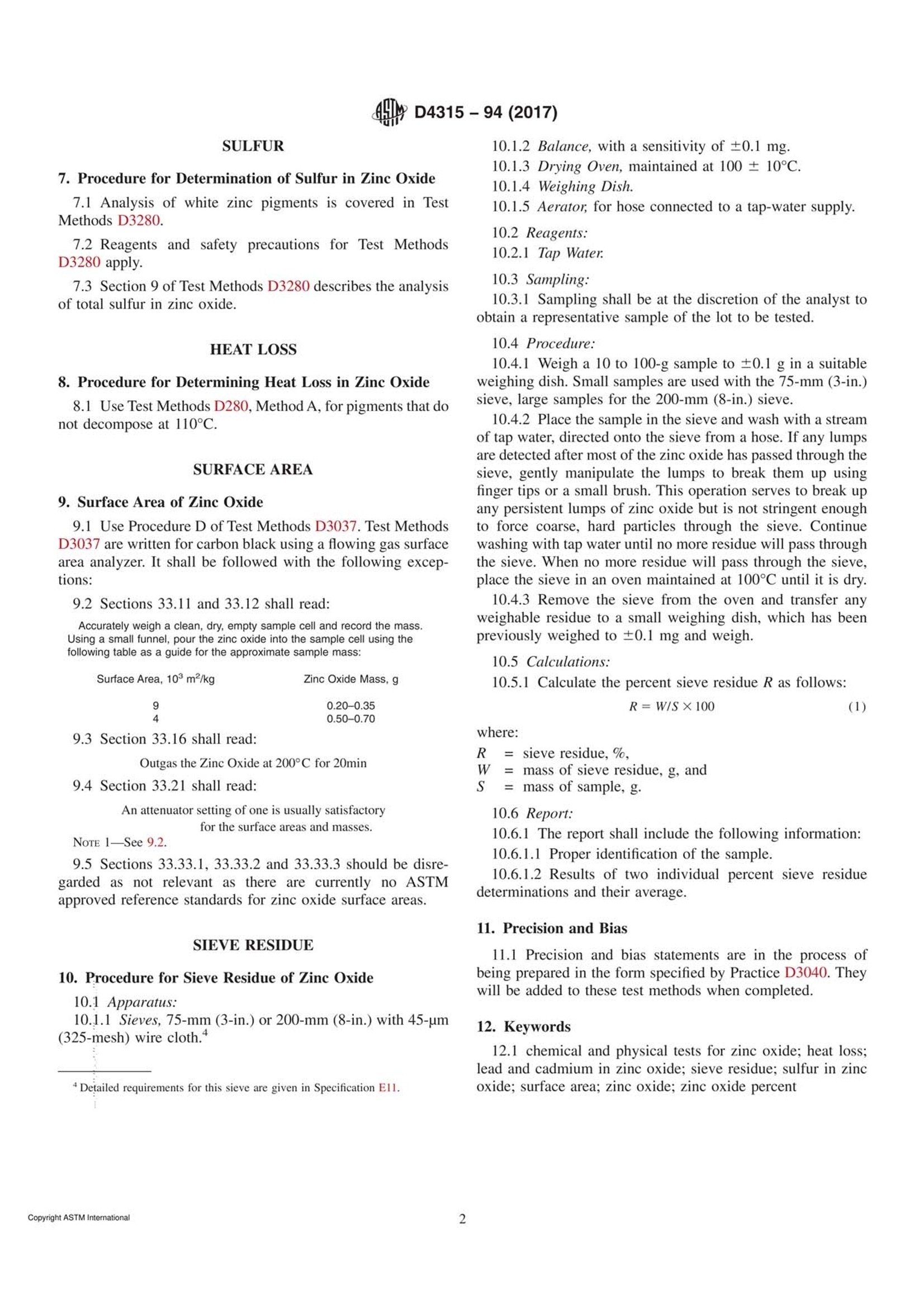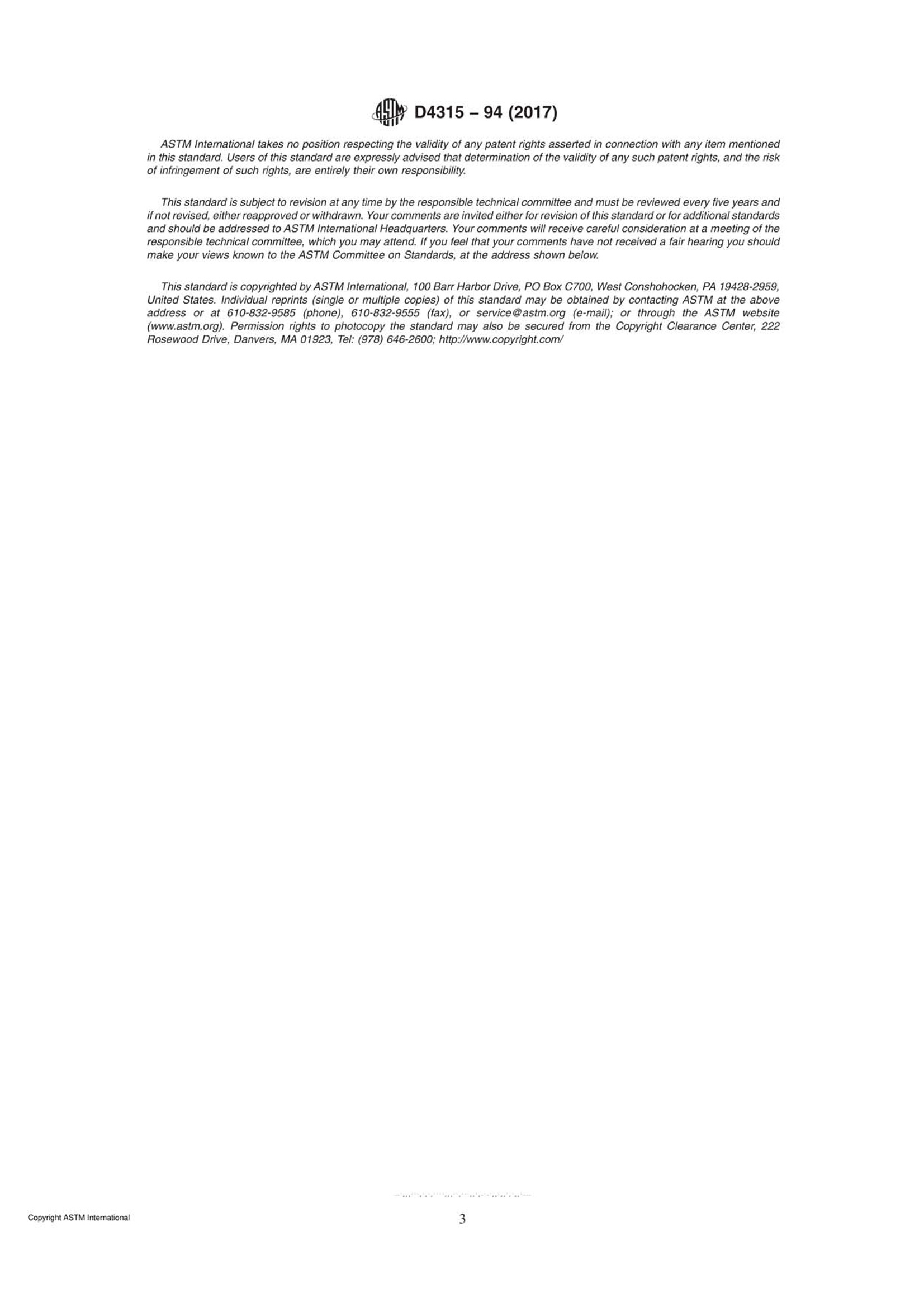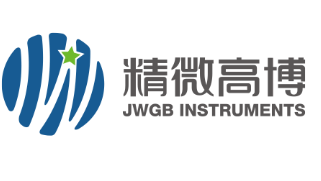
本方案详细讲述了橡胶添加剂的比表面测试过程,包括样品前处理,分析流程,数据处理等。氧化锌是天然胶乳的活性剂。有时也用作补强剂和着色剂。按其生产方法不同可分为间接法氧化锌、直接法氧化锌、活性氧化锌三种。它是橡胶工业最重要的无机活性剂,加入胶料不仅能加快硫化速度,还能提高交联度。
方案详情

This international standard was developed in accordance with internationally recognized principles on standardization established in the Decision on Principles for theDevelopment of International Standards, Guides and Recommendations issued by the World Trade Organization Technical Barriers to Trade (TBT) Committee. ly D4315-94 (2017) Designation: D4315-94 (Reapproved 2017) INTERNATIONAL Standard Test Methods forRubber Compounding Material—Zinc Oxide This standard is issued under the fixed designation D4315; the number immediately following the designation indicates the year oforiginal adoption or, in the case of revision, the year of last revision. A number in parentheses indicates the year of last reapproval. Asuperscript epsilon (e) indicates an editorial change since the last revision or reapproval. 1. Scope 1.1 These test methods cover chemical and physical tests forzinc oxide that are considered to be important to its use inrubber compounding. 1.2 The tests appear in the following order: 1.3 This standard does not purport to address all of thesafety concerns, if any, associated with its use. It is theresponsibility of the user of this standard to establish appro-priate safety and health practices and determine the applica-bility ofregulatory limitations prior to use For specificprecautions, see 5.2. 2. Referenced Documents 2.1 ASTM Standards: D280 Test Methods for Hygroscopic Moisture (and OtherMatter Volatile Under the Test Conditions) in PigmentsD1193 Specification for Reagent Water D3037 Test Method for Carbon Black—Surface Area byNitrogen Adsorption (Withdrawn 1999) D3040 Practice for Preparing Precision Statements for Stan-dards Related to Rubber and Rubber Testing (Withdrawn1987) D3280 Test Methods for Analysis of White Zinc PigmentsD4075 Test Methods for Rubber Compounding Materials- Flame Atomic Absorption Analysis-Determination ofMetals ( T h ese t es t m e th od s a r e u nder t h e ju ris d i c t i on of AST M Co mm it t ee D 1 1 on Ru b be r a nd Rubber- l i ke M at eria ls a n d are the d ir ect r e s po n sibi l i t y o f S ub comm it tee D 11 . 2 0 o n Co mp oun din g Ma t eri a ls a n d P r o ce dur e s. ) Current edition approved Feb. 1, 2017. Published February 2017. Originallyapproved in 1984. Last previous edition approved in 2012 as D4315 -94 (2012).DOI: 10.1520/D4315-94R17. "For referenced ASTM standards, visit the ASTM website, www.astm.org, orcontact ASTM Customer Service at service@astm.org. For Annual Book of ASTMStandards volume information, refer to the standard’s Document Summary page onthe ASTM website. The last approved version of this historical standard is referenced onwww.astm.org. E11 Specification for Woven Wire Test Sieve Cloth and TestSieves 3. Significance and Use 3.1 These test methods may be used for quality control ofzinc oxide used as a compounding material and for researchand development studies where zinc oxide is used in a rubbermix. 4. Reagents 4.1 Purity of Reagents-Reagent grade chemicals shall beused in all tests. 4.2 Purity of Water-Unless otherwise indicated, referencesto water shall be understood to mean Type IV reagent water inaccordance with Specification D1193. ZINC OXIDE 5. Procedure for Determination of % Zinc Oxide 5.1 Analysis of white zinc pigments is covered in TestMethods D3280. 5.2 Reagents and safety precautions for Test MethodsD3280 apply. 5.3 Section 6 of Test Methods D3280 describes the analysisof total zinc in zinc oxide using diphenylamine as internalindicator. 5.4 Section 7 of Test Methods D3280 describes the analysisof total zinc in zinc oxide using uranyl acetate as externalindicator. LEAD AND CADMIUM 6. Procedure for Determination of Lead and Cadmium inZinc Oxide 6.1 Test Methods D4075 is the standard test method formetal analysis in compounding materials using the flameatomic absorption technique. Analysis for cadmium and lead inzinc oxide are described in Sections 11 through 20 of TestMethods D4075. SULFUR 7. Procedure for Determination of Sulfur in Zinc Oxide 7.1 Analysis of white zinc pigments is covered in TestMethods D3280. 7.2 Reagents and safety precautions for Test MethodsD3280 apply. 7.3 Section 9 of Test Methods D3280 describes the analysisof total sulfur in zinc oxide. HEAT LOSS 8. Procedure for Determining Heat Loss in Zinc Oxide 8.1 Use Test Methods D280, Method A, for pigments that donot decompose at 110°C. SURFACE AREA 9. Surface Area of Zinc Oxide 9.1 Use Procedure D of Test Methods D3037. Test MethodsD3037 are written for carbon black using a flowing gas surfacearea analyzer. It shall be followed with the following excep-tions: 9.2 Sections 33.11 and 33.12 shall read: Accurately weigh a clean, dry, empty sample cell and record the mass.Using a small funnel, pour the zinc oxide into the sample cell using thefollowing table as a guide for the approximate sample mass: 9.3 Section 33.16 shall read: 9.4 Section 33.21 shall read: An attenuator setting of one is usually satisfactory for the surface areas and masses. NoTE 1-See 9.2. 9.5 Sections 33.33.1, 33.33.2 and 33.33.3 should be disre-garded as not relevant as there are currently no ASTMapproved reference standards for zinc oxide surface areas. SIEVE RESIDUE 10. Procedure for Sieve Residue of Zinc Oxide 10.1 Apparatus: 10.1.1 Sieves, 75-mm (3-in.) or 200-mm (8-in.) with 45-um(325-mesh) wire cloth.* ( D e t ai led r e q u i r em en ts f o r th i s sie v e a re giv en in S pec i fica ti on E l l . ) 10.1.2 Balance, with a sensitivity of ±0.1 mg. 10.1.3 Drying Oven, maintained at 100±10℃. 10.1.4 Weighing Dish. 10.1.5 Aerator; for hose connected to a tap-water supply 10.2 Reagents: 10.2.1 Tap Water: 10.3 Sampling: 10.3.1 Sampling shall be at the discretion of the analyst toobtain a representative sample of the lot to be tested. 10.4 Procedure: 10.4.1 Weigh a 10 to 100-g sample to ±0.1 g in a suitableweighing dish. Small samples are used with the 75-mm (3-in.)sieve, large samples for the 200-mm (8-in.) sieve. 10.4.2 Place the sample in the sieve and wash with a streamof tap water, directed onto the sieve from a hose. If any lumpsare detected after most of the zinc oxide has passed through thesieve, gently manipulate the lumps to break them up usingfinger tips or a small brush. This operation serves to break upany persistent lumps of zinc oxide but is not stringent enoughto force coarse, hard particles through the sieve. Continuewashing with tap water until no more residue will pass throughthe sieve. When no more residue will pass through the sieve,place the sieve in an oven maintained at 100°C until it is dry. 10.4.3 Remove the sieve from the oven and transfer anyweighable residue to a small weighing dish, which has beenpreviously weighed to ±0.1 mg and weigh. 10.5 Calculations: 10.5.1 Calculate the percent sieve residue R as follows: where: R= sieve residue,%,WS = mass of sieve residue, g, ann(d = mass of sample, g. 10.6 Report: 10.6.1 The report shall include the following information: 10.6.1.1 Proper identification of the sample. 10.6.1.2 Results of two individual percent sieve residuedeterminations and their average. 11. Precision and Bias 11.1 Precision and bias statements are in the process ofbeing prepared in the form specified by Practice D3040. Theywill be added to these test methods when completed. 12. Keywords 12.1 chemical and physical tests for zinc oxide; heat loss;lead and cadmium in zinc oxide; sieve residue; sulfur in zincoxide; surface area; zinc oxide; zinc oxide percent ASTM Interational takes no position respecting the validity of any patent rights asserteAPAd in connection with any item mentionedin this standard. Users of this standard are expressly advised that determination of the validity of any such patent rights, and the riskof infringement of such rights, are entirely their own responsibility. This standard is subject to revision at any time by the responsible technical committee and must be reviewed every five years andif not revised, either reapproved or withdrawn. Your comments are invited either for revision of this standard or for additional standardsand should be addressed to ASTM International Headquarters. Your comments will receive careful consideration at a meeting of theresponsible technical committee, which you may attend. If you feel that your comments have not received a fair hearing you shouldmake your views known to the ASTM Committee on Standards, at the address shown below. This standard is copyrighted by ASTM International, 100 Barr Harbor Drive, PO Box C700, West Conshohocken, PA 19428-2959,United States. Individual reprints (single or multiple copies) of this standard may be obtained by contacting ASTM at the aboveaddress or at 610-832-9585 (phone), 610-832-9555(fax), or service@astm.org (e-mail); or through the ASTM website(www.astm.org). Permission rights to photocopy the standard may also be secured from the Copyright Clearance Center, 222Rosewood Drive, Danvers, MA 01923, Tel:(978) 646-2600; http://www.copyright.com/ Copyright C ASTM Intemational, Barr Harbor Drive, PO Box C West Conshohocken, PA United StatesCopyright ASTM International opyright ASTM International 真空脱气 1 用真空装置给空样品管脱气,脱气结束用高纯氮气(5.2)或氦气(5.3)回填至大气压,将样品管从仪器上取下并称重,精确至0.1mg,记录空管质量为m1.2 称量一定量的干燥样品,确保所称量的样品的统计表面积在20m2-50m2,在漏斗的辅助下将样品装入样品管中。4 脱气结束后,用高纯氮气(5.2)或氦气(5.3)回填至大气压,将样品管从仪器上取下来并称重,精确至0.1mg,记录质量m2.5 按式(1)计算,精确至0.1mg。m0=m2-m1 …………………….(1)式中:m0 ——干品试样质量的数值,单位为克(g);m2 ——样品管与试样质量的数值,单位为克(g);m1 ——样品管质量的数值,单位为克(g); 测量步骤1 由于大多数操作都是自动进行的,因此必须彻底熟悉程序,并认真遵循操作说明。2 将液氮装入杜瓦瓶中并准确测定其饱和蒸气压。液氮的饱和蒸气压受液氮纯度及周围压力的影响,当一些杂质(例如O2)溶解在液氮中会导致液氮体系温度升高,从而导致液氮饱和蒸气压升高。3 将相对压力范围、测量的数据点、饱和蒸气压、样品质量以及其他信息录入到软件中。相对压力用实际测量的压力p和饱和蒸气压p0的比值(p/p0)表示。4 实验前应检查O型圈是否漏气。5 在样品管中插入芯棒并将样品管装在仪器上。 注:当样品管完全浸没在液氮中,液氮的液位高低可能会对实验结果造成影响。8.1.6 开始测试。吸附量根据相对压力求得.测定氮吸附表面积时数据点的选择 过程A 过程A是一种高精度的标准测试方法,在求样品氮气吸附表面积和统计表面积过程中,若压力相对范围未知,可用该方法求得。测试吸附量时,在相对压力p/p0为0 – 0.5范围内至少要测得10个均匀分布的点,最好测出20个及以上的点,这样更容易得到等温吸附曲线。在计算氮吸附表面积时,根据气体的吸附量,利用相关工具(测试软件)构建一个BET图。在BET图上选择线性最好的点,据此计算氮吸附表面积。测定氮吸附表面积时,压力范围通常选在 0.05-0.3,当然,根据吸附量的大小可以调整压力范围。计算统计吸附层厚度表面积,详见9.3和9.4. 注:具有更多数据点的吸附等温线更准确, 对其进行检测的时间更长。 过程B 过程B是一种较为简单的测试方法,当测试选点的范围确定后,可以用此方法。在相对压力范围内,根据两个或以上的数据点就可求出吸附量。根据相应公式计算氮吸附表面积。计算统计吸附层厚度表面积。 8.3 测试结果的核实 8.3.1 通常采用计算BET常数的办法来验证氮吸附表面积结果的准确性。例如炭黑,它的BET常数通常在75到250之间。测试多孔的炭黑试样时,如果相对压力在0.05 – 0.3之间,BET常数就会变成负数。在这种情况下,一边上调测量范围,一边重新测量、重新计算,直到BET常数不再是负值,测量范围的上限是V(1-P/P0)的最大值(详见ISO9277:2010, 附录C)。 8.3.2 为了确保测量精度,应该使用标准物质[1] 或内部参考资料进行 定期校验。如果测试结果在可能的范围以外,那么要重复7.2,7.3和8.1 – 8.3. 如果偏差依然存在,请咨询设备供应商。
确定



还剩1页未读,是否继续阅读?
北京精微高博仪器有限公司为您提供《氧化锌中比表面积检测方案(比表面)》,该方案主要用于锌中理化分析检测,参考标准--,《氧化锌中比表面积检测方案(比表面)》用到的仪器有








